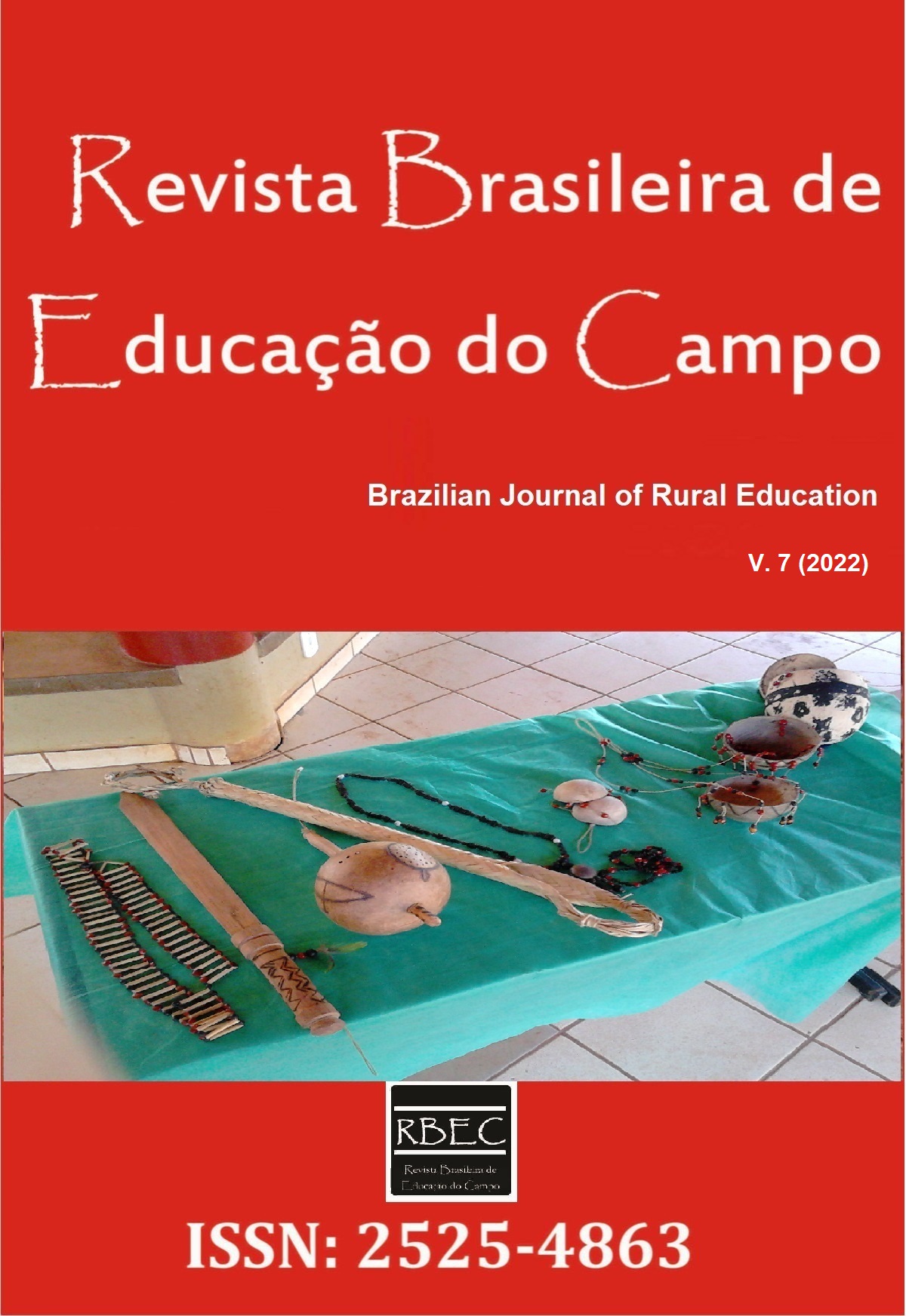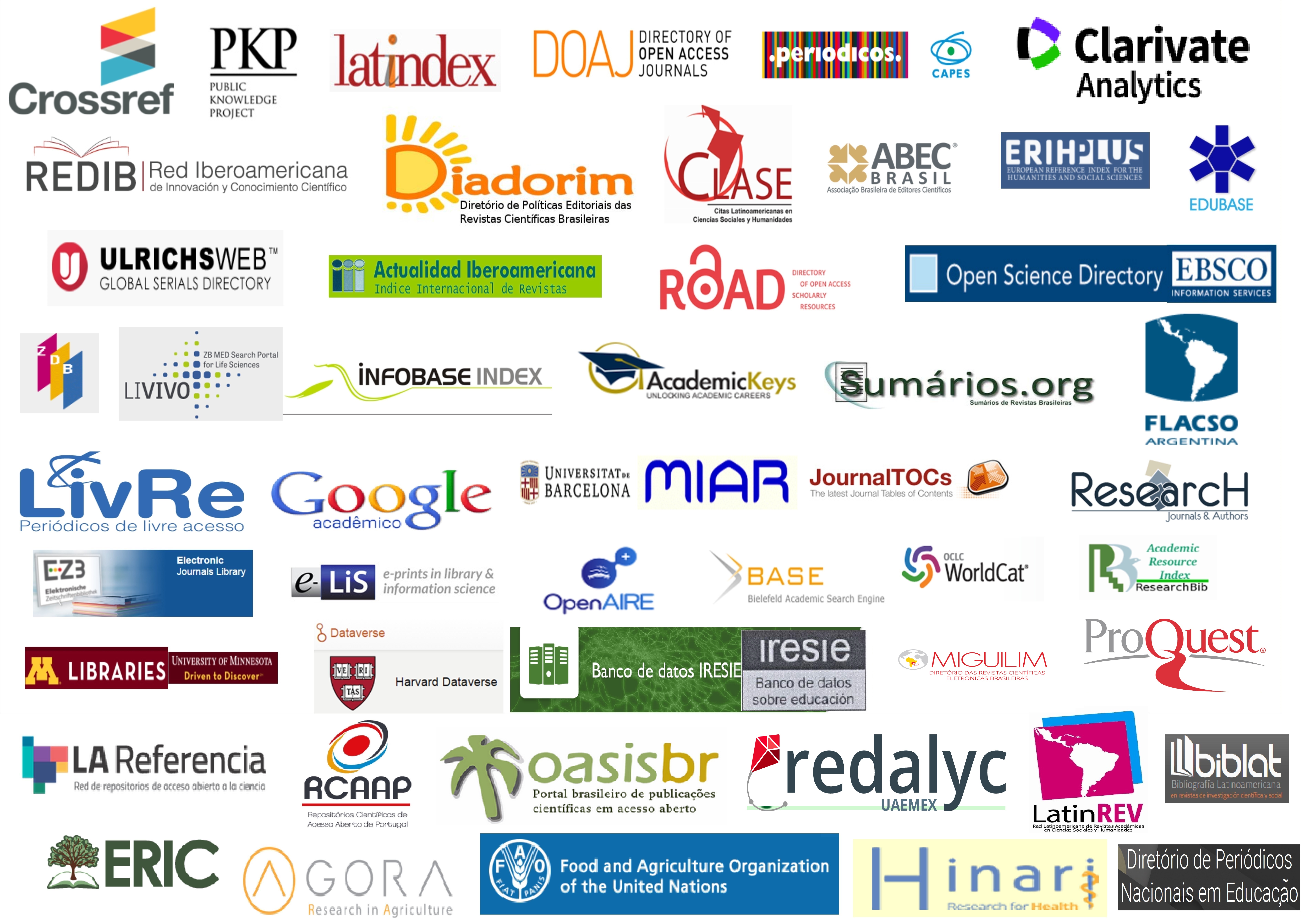Percepção da juventude rural sobre a apicultura desenvolvida em comunidades rurais do semiárido piauiense
DOI:
https://doi.org/10.20873/uft.rbec.e13617Resumo
No estado do Piauí a apicultura se apresenta como uma alternativa de geração de renda para as famílias campesinas, mais precisamente na região semiárida, que permite o reconhecimento e valorização dos saberes camponeses. O presente trabalho teve como objetivo analisar a visão dos jovens em relação à apicultura praticada no município de Massapê do Piauí. Para tanto, foi aplicado um questionário semiestruturado direcionado a 48 estudantes de comunidades rurais. Observou-se que os jovens, de maneira geral, não se identificam com as atividades rurais, embora muitos tenham algum grau de parentesco com apicultores. A maioria dos jovens apresentaram pouco conhecimento sobre a apicultura, principalmente no que se refere à prevenção de acidentes com as abelhas (ferroadas). Vale ressaltar, que muitos deles consideram as ferroadas como o maior empecilho para o ingresso na atividade. Embora saibam da importância social, econômica e ambiental da apicultura, bem como dos impactos negativos que o desaparecimento das abelhas causaria em suas comunidades, a maioria dos jovens não demonstrou interesse em participar de capacitações para iniciar-se na apicultura. Diante da notável apatia dos alunos em relação à apicultura, sugere-se ações voltadas para o conhecimento e sensibilização da juventude em relação a atividade como importante ferramenta de inclusão social e econômica para os agentes da comunidade rural.
Palavras-chave: atividade apícola, conservação das abelhas, educação do campo.
Rural Youth's perception of beekeeping developed in rural communities in the semiarid region of Piauí
ABSTRACT. In the state of Piauí, beekeeping presents itself as an alternative to generate income for peasant families, more precisely in the semiarid region. This study aimed to analyze the perception of young people in relation to beekeeping practiced in the city of Massapê do Piauí. Therefore, a semi-structured questionnaire was applied to 48 students from rural communities. It was observed that young people, in general, do not identify with rural activities, although many have some degree of kinship with beekeepers. Most young people had little knowledge about beekeeping, especially with regard to the prevention of accidents with bees (stinged). It is noteworthy that many of them consider the stings as the biggest obstacle to entering the activity. Although they know the social, economic and environmental importance of beekeeping, as well as the negative impacts that the disappearance of bees would cause in their communities, most young people did not show interest in participating in training to start beekeeping. Given the notable apathy of students in relation to beekeeping, it is suggested actions aimed at knowledge and awareness of youth in relation to the activity as an important tool for social and economic inclusion for agents in the rural community.
Keywords: beekeeping, bees conservation, rural education.
Percepción de la juventud rural sobre la apicultura desarrollada en comunidades rurales de la región semiárida de Piauí
RESUMEN. En el estado de Piauí, la apicultura se presenta como una alternativa para generar ingresos para las familias campesinas, más precisamente en la región semiárida. Este estudio tuvo como objetivo analizar la percepción de los jóvenes en relación con la apicultura que se practica en la ciudad de Massapê do Piauí. Para ello, se aplicó un cuestionario semiestructurado a 48 estudiantes de comunidades rurales. Se observó que los jóvenes, en general, no se identifican con las actividades rurales, aunque muchos tienen algún grado de parentesco con los apicultores. La mayoría de los jóvenes tenían pocos conocimientos sobre apicultura, especialmente en lo que respecta a la prevención de accidentes con abejas (aguijón). Es de destacar que muchos de ellos consideran las picaduras como el mayor obstáculo para ingresar a la actividad. Si bien conocen la importancia social, económica y ambiental de la apicultura, así como los impactos negativos que causaría la desaparición de las abejas en sus comunidades, la mayoría de los jóvenes no mostró interés en participar en capacitaciones para iniciar la apicultura. Dada la notable apatía de los estudiantes en relación a la apicultura, se sugiere acciones dirigidas al conocimiento y sensibilización de los jóvenes en relación a la actividad apícola como una herramienta importante para la inclusión social y económica de los agentes de la comunidad rural.
Palabras clave: actividad apícola, conservación de las abejas, educación rural.
Downloads
Referências
Brasil. (2007). Instituto Nacional de Pesquisas Educacionais Anísio Teixeira - INEP. Panorama da Educação do Campo. Brasília: INEP.
Amorim, L. H., & Vieira, F. E. G. (2016). A capacitação na ciência da apicultura gerando empreendedores apícolas. O desafio da escola pública paranaense na perspectiva do professor PDE. Produções didático-pedagógicas. Vol. I, Caderno PDE. Versão Online.
Brown, J. C., & Oliveira, M. L. (2014). The impact of agricultural colonization and deforestation on stingless bee (Apidae: Meliponini) composition and richness in Rondônia, Brazil. Apidologie, 45(2), 172–188. https://doi.org/10.1007/s13592-013-0236-3
Duk, C. (2006). Educar na diversidade: material de formação docente. Brasília: MEC, SEESP.
Caetano, P. (2018). Melhorar o mundo, a escola e a si próprio: os caminhos entrecruzados da experiência juvenil. ETD - Educação Temática Digital, 20(2), 413–433. https://doi.org/10.20396/etd.v20i2.8650671
Caldart, R. S. (2009). Por uma educação do campo: traços de uma identidade em construção. In Arroyo, M. G., Caldart, R.S., & Molina, M. C. (Orgs.). Por uma educação do campo (pp. 35-64). Petrópolis, RJ: Vozes. https://doi.org/10.1590/S1981-77462009000100003
Carvalho, D. M. C., Amorim, L. B., Souza, D.C., & Costa, C. P. M. (2016). Apicultura em São Raimundo Nonato, Brasil. Revista Verde de Agroecologia e Desenvolvimento Sustentável, 14(1), 85-91. https://doi.org/10.18378/rvads.v14i1.5889
Chizzotti, A. (2017). Pesquisa em ciências humanas e sociais. São Paulo: Cortez.
Façanha, A. C. (2010). Apicultura no Piauí e o desenvolvimento territorial. In Anais do Encontro Nacional do Geógrafo. Porto Alegre, RS.
IBGE – Instituto Brasileiro de Geografia e Estatística. (2021). Produção Pecuária Municipal. Recuperado de: https://sidra.ibge.gov.br/tabela/74#resultado. Acesso em: 10 out. 2022.
Lara, J. C., Eichler, B. R., Costa, J. P. R., Gomes, S, A. C., Schmitz, J. A. K., & Lara, D. M. (2021). Young farmers and agroecology: A study on the Group Boa Vista’s Young Fair, Rio Grande do Sul, Brazil. Revista Verde de Agroecologia e Desenvolvimento Sustentável, 16(3), 291-297. https://doi.org/10.18378/rvads.v16i3.8477
Lourenço, M. S. M., & Cabral, J. E. O. (2016). Apicultura e sustentabilidade: visão dos apicultores de Sobral (CE). Revista em Agronegócio e Meio Ambiente, 9(2), 93-105. https://doi.org/10.17765/2176-9168.2016v9n1p93-115
Lopes, L. G. R., & Carvalho, D. B. (2015). Dinâmica Temporal do Assentamento e os Projetos de Vida da Juventude Rural. Revista de Economia e Sociologia Rural [online], 53(4), 571-588. Recuperado de: https://doi.org/10.1590/1234-56781806-9479005304001
Matos, V. D. (2005). A apicultura no estado do Ceará: competitividade, nível tecnológico e seus fatores condicionantes, produção e exportação de mel natural (Dissertação de Mestrado). Universidade Federal do Ceará, Fortaleza. https://doi.org/10.1590/1234-56781806-9479005304001
Martins, R. D. A., Caldas, E. L. (2009). Visões do Desenvolvimento Local: uma análise comparada de experiências brasileiras. Interações (Campo Grande), 10(2). https://doi.org/10.1590/S1518-70122009000200008
Melquíades, C. C. V., Bendini, J. N., & Moura, S. G. (2020). Internal water supply in Africanized beehives during the dry season in the Brazilian semiarid. Revista Agro@mbiente On-line, 14. https://doi.org/10.18227/1982-8470ragro.v14i0.6396
Ollerton, J., Winfree, R., & Tarrant, S. (2011). How Many Flowering Plants are Pollinated by Animals? Oikos, 120(3), 321-326. https://doi.org/10.1111/j.1600-0706.2010.18644.x
Pires, C. S. S., Pereira, F. D. M., Lopes, M. T. D. R., Nocelli, R. C. F., Malaspina, O., Pettis, J. S., & Teixeira, E. W. (2016). Enfraquecimento e perda de colônias de abelhas no Brasil: há casos de CCD? Pesquisa Agropecuária Brasileira, 51(5), 422-442. https://doi.org/10.1590/S0100-204X2016000500003
Peixe, R. I. P., & Canonica, R. (2020). Saberes e fazeres de Mulheres Rurais: Algumas narrativas. Revista Educación, Política y Sociedad, 5(1), 104-123.
Rosso, L., Carmona, J. M., & Garcia, J. (2003). Sensibilizacion en el conocimiento y manejo de abejas nativas por parte de La comunidad campesina Bella Vista (El Dovio, Colombia). Memorias do Seminário Mesoamericano sobre Abejas Sin Aguijon, 3. Tapachula: Chiapas, México.
Santos, R. G., Domingos, H. G. T., Gramacho, K. P., & Gonçalves, L. S. (2017). Sombreamento de colmeias de abelhas africanizadas no Semiárido Brasileiro. Revista Verde de Agroecologia e Desenvolvimento Sustentável, 12(5), 828-836. https://doi.org/10.18378/rvads.v12i5.5407
Silva, M. G., Nobrega, E. P., Gomes, M. S., & Dantas, M. C. A. M. (2017). Riscos no ambiente de trabalho e tipos de acidentes com apicultores do município de Aparecida, Paraíba. Acta Apicola Brasilica, 5(1), 21-24. https://doi.org/10.18378/aab.v5i1.5671
Souza, R. H. V., Bendini, J. N., Gomes, T. D. A., & Brito, A.W.S. (2018). As guardiãs invisíveis das abelhas: Apicultura e gênero. In Anais do Congresso Brasileiro de Apicultura (Anais eletrônicos) Joinville, SC.
Souza, D. C. (2006). A profissionalização da apicultura no Brasil. Revista SEBRAE Agronegócios, 3.
Sousa-Junior, X. P. T., & Martins, H. M. (2019). Confissões de adolescentes: os olhares da adolescência na escola. Horizontes, 37. https://doi.org/10.24933/horizontes.v37i0.596
Troian, A., & Breitenbach, R. (2018). Jovens e juventudes em estudos rurais do Brasil. Interações, 19(4), 789-802. https://doi.org/10.20435/inter.v19i4.1768
Veloso-Filho, F. A., Souza, D. C., Silva, F. R., & Carvalho, F. P. A. (2012). A importância da cooperação produtiva nos arranjos produtivos do mel piauiense: caso Simplício Mendes. Informe Econômico, 12(28), 33-39.
Vidal, M. F. (2020). Evolução da produção de mel na área de atuação do BNB. Caderno Setorial ETENE, 5(112), 1-10.
Wanderley, M. N. B. (2007). Jovens rurais de pequenos municípios de Pernambuco: que sonhos para o futuro. In Carneiro, M. J., & Castro, E. G. (Orgs.). Juventude rural em perspectiva (pp. 35-51). Rio de Janeiro: Mauad X.
Publicado
Como Citar
Edição
Seção
Licença
Copyright (c) 2022 Josefa Andréia de Carvalho Rodrigues, Patrícia Sara Lopes Melo, Michelli Ferreira dos Santos, Maurício Fernandes da Silva, Juliana do Nascimento Bendini

Este trabalho está licenciado sob uma licença Creative Commons Attribution 4.0 International License.
Proposta de Aviso de Direito Autoral Creative Commons
1. Proposta de Política para Periódicos de Acesso Livre
Autores que publicam nesta revista concordam com os seguintes termos:
a. Autores mantém os direitos autorais e concedem à revista o direito de primeira publicação, com o trabalho simultaneamente licenciado sob a Licença Creative Commons Attribution que permite o compartilhamento do trabalho com reconhecimento da autoria e publicação inicial nesta revista.
b. Autores têm autorização para assumir contratos adicionais separadamente, para distribuição não-exclusiva da versão do trabalho publicada nesta revista (ex.: publicar em repositório institucional ou como capítulo de livro), com reconhecimento de autoria e publicação inicial nesta revista.
c. Autores têm permissão e são estimulados a publicar e distribuir seu trabalho online (ex.: em repositórios institucionais ou na sua página pessoal) a qualquer ponto antes ou durante o processo editorial, já que isso pode gerar alterações produtivas, bem como aumentar o impacto e a citação do trabalho publicado (Veja O Efeito do Acesso Livre).
Proposal for Copyright Notice Creative Commons
1. Policy Proposal to Open Access Journals
Authors who publish with this journal agree to the following terms:
A. Authors retain copyright and grant the journal right of first publication with the work simultaneously licensed under the Creative Commons Attribution License that allows sharing the work with recognition of its initial publication in this journal.
B. Authors are able to take on additional contracts separately, non-exclusive distribution of the version of the paper published in this journal (ex .: publish in institutional repository or as a book), with an acknowledgment of its initial publication in this journal.
C. Authors are permitted and encouraged to post their work online (eg .: in institutional repositories or on their website) at any point before or during the editorial process, as it can lead to productive exchanges, as well as increase the impact and the citation of published work (See the Effect of Open Access).














